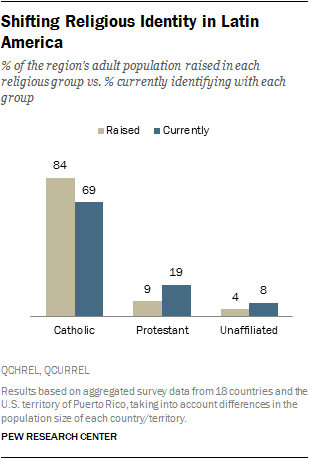By Jeff Brumley
Latin America remains a mostly Catholic region and culture but its overall numbers have taken a huge dive during the past four decades or so, a new survey by the Pew Research Center has found.
How steep a dive?
The Pew data shows the number of Catholics in Central and South America and parts of the Caribbean has plummeted from 90 percent to 69 percent since the 1960s.
“Much of the movement away from Catholicism and toward Protestantism in Latin America has occurred in the span of a single lifetime,” Pew reported. “Indeed, in most of the countries surveyed, at least a third of current Protestants were raised in the Catholic Church, and half or more say they were baptized as Catholics.”
The rise of Pentecostal and charismatic Christianity in Latin America has long been documented. The Pew data also accounts for the growth in the unaffiliated population throughout that part of the world.
But some Latinos who lead churches in the U.S. and Latin America say the overall decline of the Catholic Church across the region is most visible in the continual proliferation of non-Catholic Christian traditions.
Independent churches fare well
“I don’t see less Catholics but I see more evangelicals,” said Ruben Ortiz, former moderator of the Cooperative Baptist Fellowship of Florida and pastor of La Primera Iglesia Bautista, a CBF congregation in Deltona, Fla.
Ortiz is a native Cuban who lived in Ecuador for several years before moving to the U.S. He also travels widely in Latin America on missions and attending conferences. Each of those trips reveals a decidedly larger number of mostly Pentecostal churches than previous visits.
“Their leadership is very young and energetic,” Ortiz said.

Those leaders and lay people will quickly report they are former Catholics who attended Mass only once or twice a year. But now they attend “faithfully,” he said.
This trend does not spell easy pickings for U.S.-based denominations seeking a greater presence in Latin America, said Jesus Garcia, pastor of Metropolis Baptist Church in Carolina, Puerto Rico.
The dually aligned American Baptist Churches and CBF congregation has missions in the Dominican Republic. But Garcia said denominational churches have been stuck for some time.
“I see more non-denominational than historical churches” growing in Puerto Rico, he said. It means Baptists and other traditional congregations must awaken.

“I think it’s a good time to watch and evaluate and see a new strategy for evangelism.”
Garcia said his is one of 113 ABC churches – and the only CBF congregation – on the island. It and others are often hampered by the committee-based process for decision making. Independent churches don’t have that problem.
“They are growing faster,” he said. “This is a time when people are moving fast and they want a decision.”
Reasons for optimism
And sometimes that decision is for no church at all, Pew researchers found.
“While the Catholic Church has lost adherents through religious switching, both Protestant churches and the religiously unaffiliated population in the region have gained members,” according to the study.
It said 9 percent of Latin Americans were raised in Protestant churches compared to 19 percent who describe themselves as Protestants now, Pew said.
“And while only 4 percent of Latin Americans were raised without a religious affiliation, twice as many (8 percent) are unaffiliated today.
Still, most have left for other churches where they reported finding a more satisfying church and worship experience.

Most former Catholics said they were seeking “a more personal connection with God,” while others said “they wanted a different style of worship,” the survey found.
One needn’t travel to Latin America to see those trends unfolding, Ortiz said, because many Latinos use their arrival in the United States as a good time to leave Catholicism.
“They are leaving Catholic churches to go to evangelical churches,” he said. “It’s a natural part of their adaption in coming to the U.S.”
The reasons they cite when joining Ortiz’ church, he said, are similar to those Pew found from its survey.

“They said they are impressed with a joyful service that is non-liturgical.”
All the changes occurring in Latin America mean U.S.-based religious groups should also be optimistic, he added.
Latin America is a place “where you can go freely and find churches and send a lot of missionaries,” Ortiz said. “There are a lot of opportunities to be faithful and share the good news.”
